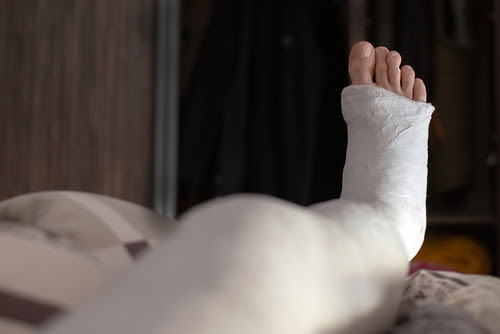Prior Broken Leg Still Causing Issues? Some New Perspectives on Why
The theme for this week …
What happens with your bones directly affects the muscles. When bones are immobilized for healing, the muscles tend to go offline impacting your ability to be active.
This week we look at how a prior broken leg can still impact you years later. Read on …
Leg fracture + cast = odd pains
At the Bridging® Institute we’ve come to realize that the source of most pain is not a simple as it seems. When someone has had a leg cast in their past, we know the immobilization often plays a role in more recent challenges, often including odd, deep pains.
The tibia, between the ankle and knee, is the most common long bone fractured with about 492,000 per year in the US.
The tibia is most often fractured by two mechanisms — a high energy impact, or a low energy impact accompanied by a torque.
- High energy fractures are often from auto collisions or sports injuries, especially soccer.
- Low energy fractures are often from falling or sports injuries involving a twist between the knee and ankle.
The most common types of treatment, depending upon the severity of break, are a long cast or surgery. You can read more about tibial fractures in this overview from the National Institutes of Health.
How does a cast shutdown muscle function and movement?
While the cast is holding the bone together so it can heal, the muscles are held captive too.
The micromovements within muscles and between muscles shuts down. Because these tiny movements are like a chain of dominoes, they need tiny movements to restart the chain reaction. When the cast is cut off, exercises alone aren’t enough to get these tiny muscle relationships working again.
These tiny movements are the basis for smooth coordination of the foot with the ankle, knee, hip, and lower back. Often people who have had a cast say their leg feels heavier and they feel pain that nothing seems to help. Even years later!
How are the hibernating micromovements restored?
We find that resetting leg movement is a three-step process including:
- Waking-up the muscles
- Guiding the muscles to move and connect with their neighbors across adjacent joints.
- Helping the muscles practice
Once this process of bringing the muscles back online is complete, agility training and strengthening will yield better results. As function improves, the pain calms down.
Yes, the leg muscles can change!
The good news is that these all change with the Bridging® Technique. Bridging® rebuilds the structural relationships within the leg enabling strength, balance, and flexibility.
You can once again move with ease and confidence!
Insight of the week from Cara
Karen’s ease of walking had yet to fully recover. She had a meniscus tear six months ago and had gone through therapy. Her knee really didn’t feel strong, and her leg visually looked crooked.
What Karen also had in her past was a broken leg that was in a cast for about 12 weeks.
Why does a prior broken leg matter to her recovery?
Although the current injury was to her knee, her leg just felt stiff and solid. Not a willing participant which should be ready to move with all the necessary finesse that a leg moves with.
The cast from years ago caused the smaller, fine movements between muscle fibers to shut down. This caused the heavy, lethargic sensation in her leg.
Yes, Karen’s leg could move but not fluently. Her knee was stressed from stiffness in her leg muscles. The nice elastic feeling that the muscles around her knee should have was non-existent.
How did Bridging® help?
Once realizing the issue with her knee recovery was related to the missing ease of transition related to the prior leg cast, the path of action became clearer.
In the video you will see the following steps we used to get Karen’s leg micromovements working again:
- Waking up the muscles in her entire leg by using peanut balls to surround and gently rock her leg.
- Guiding the muscles through basic transitions around the knee, ankle and hip.
- Helping the muscles practice basic movements with a little resistance.
She felt the lightness in her leg afterward, including a sensation of feeling longer!
There are next steps for Karen’s leg which include refining the muscle coordination to better support improved strength, agility, and balance.
Most importantly, in this session Karen’s knee and leg are now moving more easily and smoothly!

